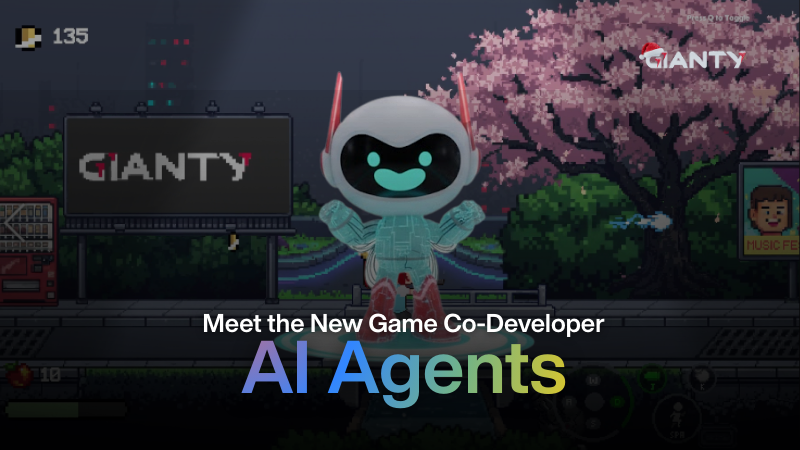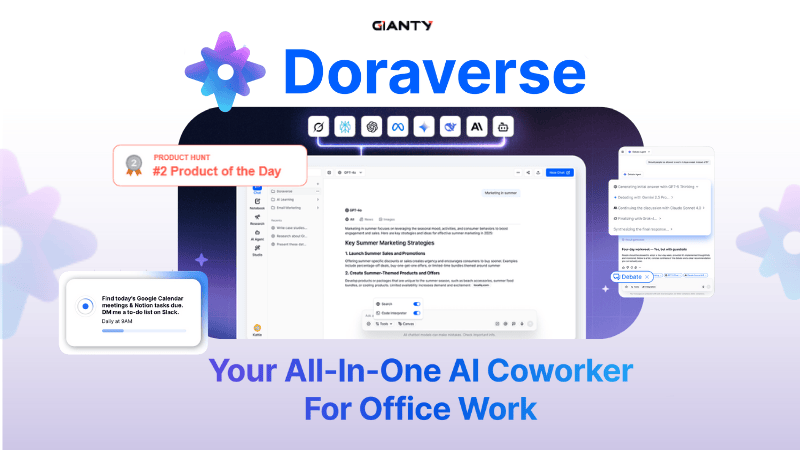MCP (Model Context Protocol) is changing the way enterprise AI systems connect and work together.
In most enterprises, AI systems don’t fail because the models are weak – they fail because the systems around them can’t communicate. Data sits in silos, integrations break with every update, and every new connection needs custom code that’s hard to maintain.
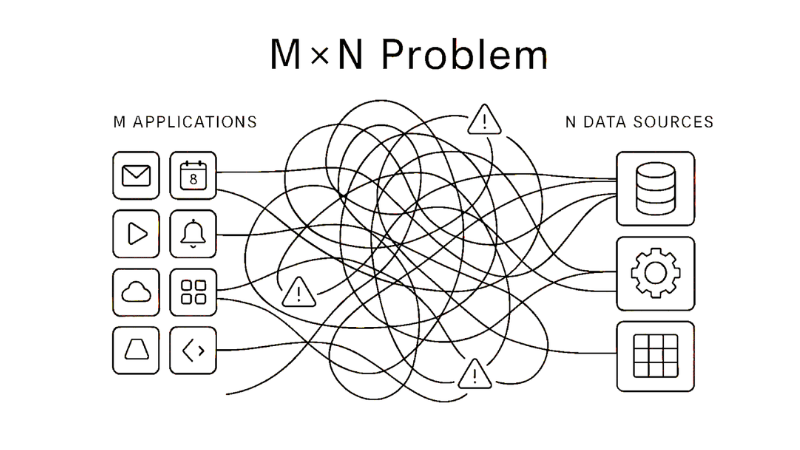
MCP fixes that by providing a unified standard for communication between AI models, tools, and data sources. Instead of manually stitching APIs and scripts, MCP gives everything a shared language so your AI systems can finally interact smoothly and scale without chaos.
In this article, we’ll break down what MCP is, why it matters, and how it could finally make AI integration in enterprises fast, flexible, and sustainable.
What is MCP (Model Context Protocol)?
Enterprise AI Integration Problems
A survey found that 67% of AI decision-makers plan to increase generative AI investment within this year, and IDC predicts over 40% of core IT spending will go to AI initiatives. Yet as enterprise AI adoption accelerates, most models still operate in isolation and unable to tap into the real-time data and business tools that give AI true context and value.
AI integration in enterprises sounds simple until it’s time to connect with real tools, internal databases, or APIs. That’s when things get messy fast.
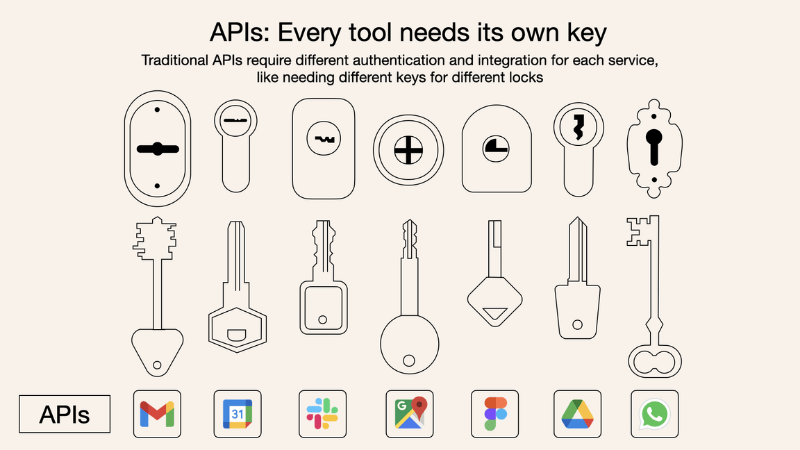
Soon, your setup is filled with fragile patches, custom scripts, and one-off code that barely hold together. Each system speaks a different language, and even small updates can break the entire workflow.
What you really need is a “bridge” – something that connects everything smoothly, without all the manual fixes and chaos. That’s where MCP comes in.
MCP (Model Context Protocol) Definition
MCP (Model Context Protocol) is an open protocol that enables seamless integration between AI or LLM-based applications and the external tools, data, and workflows they rely on.
In practice, MCP allows AI systems like Claude or ChatGPT to easily connect to:
- Data sources such as local files, databases, or APIs
- Tools like search engines, analytics functions, or automation services
- Workflows including specialized prompts or multi-step processes
In short, MCP gives AI the ability to reach beyond its own model and interact with the systems where real work happens.
You can think of MCP as the USB-C port for AI. Just as USB-C provides a universal way to connect different electronic devices, MCP provides a standardized way for AI applications to connect to any tool, dataset, or workflow without the need for complex, custom integrations.
By using a single, consistent protocol, MCP creates a “structure” that allows AI systems to work seamlessly with the tools and data that already power your business.

How MCP Works
So how does MCP actually make all these systems work together? Instead of hardcoding connections, MCP follows a simple client–host–server model. Each part has a clear role:
- Host: The “AI hub.” It manages the overall workflow from gathering context, choosing tools, to coordinating responses. Examples include AI agents, IDEs, or chatbot platforms like Claude.
- Client: The connector between host and server. It handles communication, sending requests, and receiving results.
- Server: The provider of capabilities. It connects to tools or data sources (like Slack, Gmail, Google Calendar, or local files) and exposes specific functions the AI can use, such as “search messages,” “read file,” or “check schedule.”
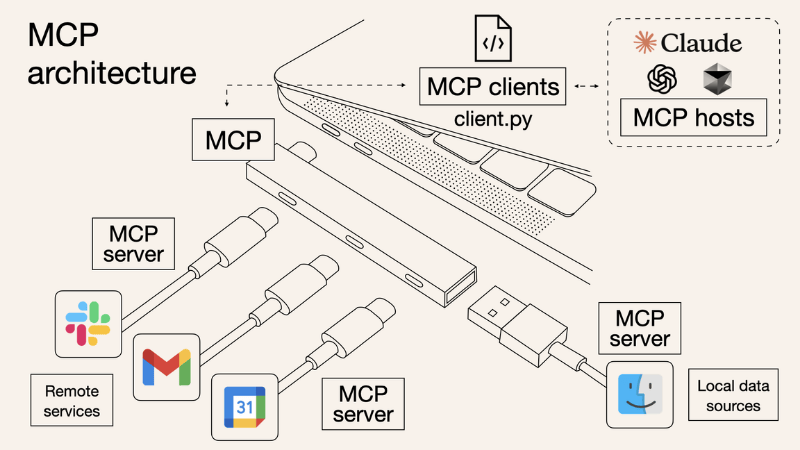
What Can MCP Servers Provide?
MCP servers are flexible gateways that let AI systems access everything they need from the outside world.
They expose three main types of capabilities:
- Prompts: Structured ways for AI to send requests and receive consistent responses. These can be predefined templates or commands that help standardize how AI interacts with servers.
- Resources: Real data the AI can read or query from connected systems, for example, files, CRM records, or customer databases. This gives AI access to live, relevant information instead of static inputs.
- Tools: Actions the AI can trigger, such as sending an email, creating a report, or updating a document in another app.
Each MCP server provides one or more of these capabilities – all using the same protocol.
That’s what makes MCP modular: you can connect new data or functions just by adding another server, and everything still works together seamlessly.
Why Does MCP Matter?
MCP isn’t just another AI framework; it’s a way to make AI systems actually usable across real enterprise environments.
Here’s why it matters:
- Standardization: MCP gives AI systems a common way to connect with tools and data, much like how APIs standardized web development. This removes the need for endless custom integrations, so teams can build and deploy faster with far less maintenance.
- Flexibility and Scalability: Because MCP works across models and providers, developers can switch or upgrade LLMs without breaking existing integrations. It supports multiple communication methods, making it easy to scale across different tools and departments.
- Smarter, Context-Aware AI: MCP allows AI models to connect with live data and real tools, turning them from simple text generators into context-aware systems that can understand, act, and deliver results in real workflows.
In short: MCP turns isolated AI models into connected, operational AI systems – the kind that can actually deliver value at enterprise scale.
The Real Advantages of MCP
If a service starts to get heavy usage, you don’t rebuild anything. You just deploy another MCP server of the same type, and it joins the network instantly. That’s how MCP keeps your AI ecosystem modular, flexible, and reliable from the start.
Here’s what this unlocks for enterprises:
Reusability: Build once, use everywhere. The same Slack or CRM server you create for one project can be reused across ten others. You can even swap out AI models from Claude to Gemini or OpenAI without rewriting your workflow.
Scalability: MCP is built to grow. Servers can run on different machines, across teams, or even between organizations all connected through the same architecture. It’s distributed by design, so scaling doesn’t mean starting over.
Cost Efficiency: Shared, reusable servers mean you’re not rebuilding the same integrations again and again. That cuts development time, reduces infrastructure costs, and lets you move workloads wherever it’s most cost-effective.
By replacing fragile integrations with a unified standard, MCP breaks old enterprise AI architectures and modernizes AI development.
MCP Use Cases
Smarter Vendor Negotiations for Finance Teams
Large enterprises often manage hundreds of vendor contracts and each with different pricing terms, renewal dates, and points of contact. Without a connected system, finance and procurement teams waste time digging through emails, ERP data, and old documents.
With MCP, an AI assistant can consolidate all that information in real-time.
- It retrieves past communication, payment terms, and contract details from connected systems like ERP and email.
- It analyzes this data to suggest negotiation strategies or highlight cost-saving opportunities.
- During ongoing discussions, it stays synced through MCP, updating insights or even drafting follow-up emails automatically.
Impact: Finance teams can handle renewals faster, negotiate more effectively, and make data-driven decisions without switching between multiple tools. MCP connects everything behind the scenes.
Powering Customer-Facing Support Chatbots

Enterprises that handle large volumes of customer requests often rely on multiple support tools: ticketing systems, knowledge bases, and communication platforms — that don’t always work together smoothly.
With MCP, companies can connect their AI-powered support chatbots directly to these systems and enable multiple LLMs (like GPT-4o or Claude 3.5) to work together seamlessly. Through MCP servers, the chatbot can read and write data across support applications such as retrieving open tickets, checking issue history, or updating case statuses automatically.
Conclusion
MCP marks a turning point in how enterprises build and scale AI. It brings structure and consistency to a space that’s long been held back by fragmented tools and one-off integrations.
By creating a shared language between AI systems, data, and workflows, MCP transforms AI from an isolated experiment into a connected part of enterprise operations. It gives teams the freedom to innovate faster, integrate safely, and grow without the hidden costs of technical debt.
More than a framework, MCP represents a shift in mindset from maintaining connections to designing intelligent systems that evolve with your business.
FAQs
- Is MCP a piece of software or an AI application?
Not exactly. MCP is a protocol. That means it’s a set of technical rules and standards. MCP provides the framework that lets AI systems like LLMs or AI Agents connect with external tools and data in a consistent, structured way. You don’t “install” MCP like an app, instead, you use tools or build systems that follow the MCP standard.
- Can small and medium-sized enterprises (SMEs) benefit from MCP, or is it only for large enterprises?
MCP benefits organizations of all sizes. While building custom MCP servers may initially require some technical resources, the long-term gains – smoother AI integrations, smarter automation, and personalized workflows are valuable for any business.
As MCP adoption grows, we’ll likely see more plug-and-play solutions that make it easy for SMEs to use MCP-ready tools that can instantly connect to a company’s data.
- Is implementing MCP complicated or expensive? Who should be responsible for it?
The complexity and cost depend on your existing tech setup. Building custom MCP servers to connect internal data and tools will usually require your IT or development team.
However, there’s another key role: identifying high-value use cases, defining clear business goals, and evaluating performance once the system is live. Ultimately, MCP works best when IT and business leaders collaborate – combining technical execution with strategic vision
- Does MCP replace APIs?
Not necessarily. Traditional APIs remain essential for many direct integrations.
MCP doesn’t aim to replace APIs – it builds on top of them to handle more complex, context-driven AI interactions. Think of MCP as a standardized communication layer that lets AI access and use APIs more intelligently.



